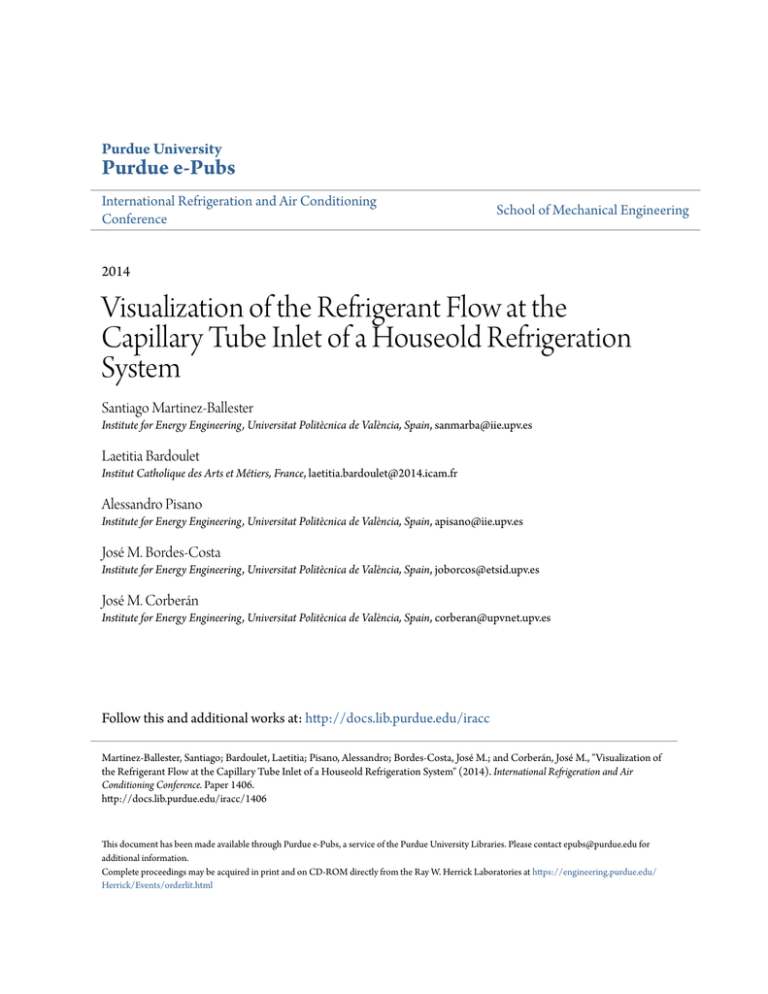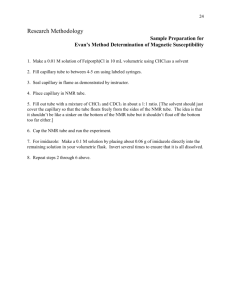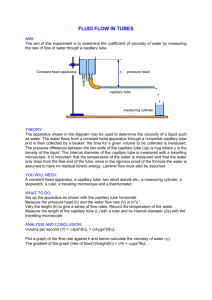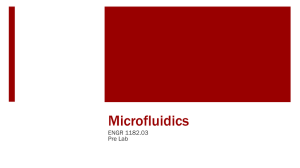Visualization of the Refrigerant Flow at the Capillary Tube Inlet of a
advertisement

Purdue University Purdue e-Pubs International Refrigeration and Air Conditioning Conference School of Mechanical Engineering 2014 Visualization of the Refrigerant Flow at the Capillary Tube Inlet of a Houseold Refrigeration System Santiago Martinez-Ballester Institute for Energy Engineering, Universitat Politècnica de València, Spain, sanmarba@iie.upv.es Laetitia Bardoulet Institut Catholique des Arts et Métiers, France, laetitia.bardoulet@2014.icam.fr Alessandro Pisano Institute for Energy Engineering, Universitat Politècnica de València, Spain, apisano@iie.upv.es José M. Bordes-Costa Institute for Energy Engineering, Universitat Politècnica de València, Spain, joborcos@etsid.upv.es José M. Corberán Institute for Energy Engineering, Universitat Politècnica de València, Spain, corberan@upvnet.upv.es Follow this and additional works at: http://docs.lib.purdue.edu/iracc Martinez-Ballester, Santiago; Bardoulet, Laetitia; Pisano, Alessandro; Bordes-Costa, José M.; and Corberán, José M., "Visualization of the Refrigerant Flow at the Capillary Tube Inlet of a Houseold Refrigeration System" (2014). International Refrigeration and Air Conditioning Conference. Paper 1406. http://docs.lib.purdue.edu/iracc/1406 This document has been made available through Purdue e-Pubs, a service of the Purdue University Libraries. Please contact epubs@purdue.edu for additional information. Complete proceedings may be acquired in print and on CD-ROM directly from the Ray W. Herrick Laboratories at https://engineering.purdue.edu/ Herrick/Events/orderlit.html 2228, Page 1 Visualization of the Refrigerant Flow at the Capillary Tube Inlet of a Household Refrigeration System Santiago MARTÍNEZ-BALLESTER1,*, Laetitia BARDOULET2, Alessandro PISANO1, José M. BORDES-COSTA1, José M. CORBERÁN1 1 Universitat Politècnica de València, Institute for Energy Engineering, Camino de vera, s/n, Valencia, 46022, Spain Tel.: +34 963 879 12, E-mail address: sanmarba@iie.upv.es (S. Martínez). 2 Institut Catholique des Arts et Métiers, ICAM, Avenue de Grande Bretagne 75, Toulouse, 31300, France. * Corresponding Author ABSTRACT Subcooled conditions at the condenser outlet ensure complete condensation, which is necessary to increase the cooling capacity and ensure the liquid conditions at the expansion device inlet in vapor compression systems. However, in household refrigerators, recent works point out the presence of two-phase flow at the capillary tube inlet. These systems behave quite different from others refrigeration systems due to the extreme low capacity, about 80 W. In the present work, a test bench was built to visualize the refrigerant flow the capillary tube inlet of a household refrigerator. Three transparent filters were installed with different orientations and different positions of the capillary tube within them were tested. The tests allowed visualizing clearly the refrigerant conditions at the capillary tube inlet. In addition, the temperature profile along the condenser wall was analyzed. The results show that, for the refrigerator analyzed, the capillary tube always draws in two-phase flow in steady conditions. The temperature profile and other factors analyzed pointed out to the fact that there is not effective subcooling in this appliance. 1. INTRODUCTION Household refrigerators are equipped with capillary tube as expansion device due to its simplicity and low cost. For avoiding the presence of liquid at the compressor inlet when it starts-up, the capillary tube can be placed in thermal contact with the suction line working as a liquid-to-suction heat exchanger (CT-LSHX). Furthermore, this design solution will prevent the sweating on the suction line if its temperature is below the dew point temperature. This solution is adopted in most of the household refrigerators, mainly with two different configurations: concentric tubes or lateral (Hermes et al., 2008). The main disadvantage of this kind of expansion device is that it has a quite limited capacity to control the system. Other alternatives, such as variable expansion valve, are still not commercially available for household refrigerators (Ronzoni et al., 2013) due to their low cooling capacities (around 100 W). The CT-LSHX introduces complex phenomena due to simultaneous two-phase flow expansion and heat transfer, such as reverse heat transfer (Bansal and Yang, 2005), flow hysteresis and flow oscillations (Liu and Bullard, 1997). Some of the negative consequences of these phenomena are the following: noise, due to re-condensation (Hartmann and Melo, 2013), which is becoming an important quality issue; and reduction of the CT-LSHX effectiveness (Liu and Bullard, 1997), which affects the global efficiency. Studies about how to solve the noise problem show that it disappears when there is enough subcooling at the capillary tube inlet (Hartmann and Melo, 2013). This fact also supports the idea that two-phase flow at the capillary tube inlet contributes to the re-condensation phenomenon inside the CT-LSHX. Besides the problem of noise, another important consequence of the liquid absence at the condenser outlet is the loss of global efficiency, due to the reduction of cooling capacity given the same compression work. Boeng and Melo (2012a) performed an experimental study to find the optimal combination of refrigerant charge and capillary tube in a refrigerator-freezer of 403 liters equipped with R600a. For varying the expansion device capacity, they used a needle valve instead of a real capillary tube. Boeng and Melo (2012b) complemented the previous work by means of applying a model (Hermes et al., 2008) to develop a correlation between the valve opening degree and 15th International Refrigeration and Air Conditioning Conference at Purdue, July 14-17, 2014 2228, Page 2 the equivalent capillary diameter. They obtained a good prediction of the mass flowrate excepting for the tests with fully open valve or subcooling less than 5 K. By visualization of the capillary tube inlet, Boeng and Melo (2012b) concluded that even with a certain subcooling of 5 K, the inlet was two-phase flow. They pointed out as possible explanation that at the capillary inlet there is a non-equilibrium mixture of subcooled liquid and saturated vapor, instead of being purely liquid. Finally, they could evaluate numerically that the vapor quality at the capillary tube inlet ranged between 2-12%, depending on the refrigerant charge. Inan et al. (2003) visualized, with X-ray equipment, the filter, the accumulator at the evaporator outlet, and the section at the evaporator inlet in a refrigerator-freezer of 435 liters equipped with R134a. They clearly identified fully liquid conditions at the capillary tube inlet and, in few minutes after compressor start-up, the filter was completely full of liquid. The value for the subcooling was of 5 K when quasi-steady conditions were reached. Thus, regarding the inlet conditions to the capillary tube the observations of Inan et al. (2003) are different to those observed by Boeng and Melo (2012b). One of the reasons could be the fact of running the system with different refrigerant mass flow rates because of using different refrigeration fluids. In literature, the subcooled condition at the capillary tube inlet is always reported, however the cited problems of noise and conclusions of other works (Hartmann and Melo, 2013; Boeng and Melo, 2012b) point out that these conditions maybe are not real. Different reasons may explain it: non-equilibrium between subcooled phase and saturated vapor at capillary inlet; the small compressor capacity compared with the expansion device capacity of the capillary tube used. This latter factor is becoming more important since nowadays a high efficiency refrigerator-freezer of a volume of 330 liters is consuming a continuous power about only 20 W (0.48 kWh/day). In literature all the data reporting a certain subcooling is supported always with temperature measurements on the wall surface. To deepen this phenomenon an experimental work of visualization is clearly needed. To the author’s knowledge, there are not specific experimental works focused on the evaluation of the actual condenser outlet conditions in high efficiency refrigerators with extreme low capacities. Therefore, the main objective of this work is to assess by visualization the actual conditions taking place at the capillary tube inlet. A novel test bench has been designed in order to visualize and analyze the phenomena occurring along the filter and at the capillary tube inlet. 2. EXPERIMENTAL SET-UP 2.1 Test Bench The original apparatus is a high efficiency (approximately 0.48 kWh/day) two-door refrigerator-freezer of 330 liters, no-frost, equipped with R600a. It consists of a fin and tube evaporator, a tube and wire condenser and a variable-speed 7 cm3 hermetic reciprocating compressor. It has been partially modified adding different transparent sections as well as an extra section that allows testing rapidly several positions of filters and capillary tube (Figure 1). Transparent section Transparent filters Figure 1: Test bench Figure 2: Transparent filter 15th International Refrigeration and Air Conditioning Conference at Purdue, July 14-17, 2014 2228, Page 3 The original expansion device, a capillary tube with liquid to suction heat exchanger (CT-LSHX), has been replaced by an experimental facility made up of three capillary tubes wrapped up around the suction line. Each capillary tube has a total length equal to 2.44 m, internal diameter of 0.6 mm and is connected to a different transparent filter (Figure 2). A net of tubes and valves allows selecting operating capillary tube and filter. The three filters are positioned differently in order to investigate the effect of their orientation on the flow pattern at the condenser outlet and at the capillary tube inlet; two of them are in vertical position, but with opposite flow direction, while the third is horizontally oriented. The temperatures are monitored by a set of thermocouples (type T) located along the refrigerant circuit (Figure 3) and inside both the fresh food cabinet (FF) and the freezer cabinet (FZ). The pressure is measured by means two pressure transducers (P1 and P2) positioned at the condenser outlet and in the suction line. The experimental apparatus is placed in a climatic chamber and equipped with a system for data acquisition and processing. Figure 3: Position of pressure transducers and thermocouples PT100 2.2 Experimental Campaign The experimental tests are focused on the visualization of the refrigerant flow at the condenser outlet and at the capillary tube inlet in order to conclude about the real state of the refrigerant at the condenser outlet. Nine different configurations have been tested (Table 1) involving three filter orientations. Each filter determine the direction of the refrigerant flow while for each filter, three positions of the capillary tube within the filter are tested. The total capillary tube length was always kept constant. A preliminary optimization study established the refrigerant charge (57 grams) used during the whole experimental campaign. The environmental conditions in the climatic chamber have been maintained at a temperature of 25C. During the tests, the refrigerator is controlled by its electronics, alternating two different operating modes: FF+FZ (or Dual mode), when the air from evaporator is supplied to both fresh food cabinet (FF) and the freezer cabinet (FZ); FZ (Freezer mode), when the air from the evaporator is only supplied to the freezer because the fresh food cabinet is already within the setting range of temperature. When in the freezer the lowest temperature is achieved, the compressor switches off. The cycle starts again when the air inside the cabinets warms up due to the heat losses. 15th International Refrigeration and Air Conditioning Conference at Purdue, July 14-17, 2014 2228, Page 4 Table 1: Matrix of tests Filter orientation Flow direction Vertical From the top to the bottom Vertical From the bottom to the top Horizontal Horizontal Capillary tube position inside the filter Top Middle Low Top Middle Low Top Middle Low Nº 1 2 3 4 5 6 7 8 9 3. RESULTS AND DISCUSSION 3.1 Temperature profiles The condenser temperature profile is analyzed in Figure 4. In both operating modes, when the compressor is turned on, the discharge temperature turns out to be the highest one. The saturation temperature (evaluated at the condenser pressure) is constantly slightly higher than the temperature measured by the thermocouples on the wall where condensation is expected to be present. The only explanation for this fact is that, although the thermocouples are well insulated, a heat transfer flows due to longitudinal heat conduction trough the tube reduces the temperature measured. Consequently, when the internal heat transfer coefficient (HTC) changes, this difference of temperature also change. Figure 4: Condenser temperature profile In Figure 4, the sensors T1-T6 measure approximately the same temperature (about 32.5°C) with variation less than 0.5K, but the temperature measured by the thermocouples T7 and T8 (Figure 3) are slightly lower. The two-phase flow area is clearly highlighted by the first set of temperature, while the temperature in T7 and T8 allow thinking that a certain subcooling exists. Refrigerant charge and subcooling are strongly connected: when the refrigerant charge increases, also the subcooling increases. However, in this system was observed that increasing the refrigerant charge the condenser subcooling remained constant. Given this situation, presence of subcooled liquid is doubtful and two explanations can be drown: either the outlet conditions have a certain vapor quality or the filter is operating as a liquid receiver, thus, the saturated conditions are present at the condenser outlet. In fact, if we observe the difference in temperature between T7-T8 and 15th International Refrigeration and Air Conditioning Conference at Purdue, July 14-17, 2014 2228, Page 5 T1-T6 (instead of using saturated temperature as reference) the difference is rather small. If we assume certain longitudinal heat conduction, as previously justified, this small difference can be explained because of the variation of the HTC, which is reduced in the final part of the condenser. 3.2 Visualization of the refrigerant flow at the capillary tube inlet Figures 5, 6 and 7 depict the flow conditions at capillary tube inlet for many arrangements shown in Table 1. The images were taken when the quasi-steady state conditions were established and did not show noticeable differences between both operating modes, FF+FZ (Dual mode) and FZ (freezer mode). Figure 5 shows the different flow condition at the capillary tube inlet during the tests 1-3 of Table 1, which are characterized by having the capillary tube inlet at the bottom of the filter and the refrigerant flowing downwards. The refrigerant coming from the condenser drops in the filter from the top to the bottom. Here, the liquid fills the filter until reach the level defined by the section where the capillary tube inlet is. The flow at this section was quite unstable showing fast and short (1 millimeter approximately) oscillations due to the droplets falling down from the filter. Most of the time, the flow condition corresponded to the one depicted in the Figure 5, where can be observed that, once the liquid reaches the capillary tube inlet, a small vortex appears. This phenomenon highlights that the capillary tube sucks both liquid and vapor. In order to demonstrate that the filter is not working as a liquid accumulator, the position of the capillary within the filter was varied (Test 2 and 3) respect to the Test 1. By observing the figures is evident that the liquid level always follows the capillary tube inlet. Figure 5 shows clearly that, regardless by its position, the capillary tube draws in refrigerant with a certain amount of vapor. In fact, the filter contains always a constant amount of vapor and liquid that comes from the filter walls and from the liquid droplets. This amount depends on the position of the capillary tube within the filter. Test 1 Test 2 Test 3 Figure 5: Refrigerant flow at the capillary tube inlet during the test 1,2 and 3 Figure 6 show the corresponding tests for the filter mounted in the opposite direction; the refrigerant comes from the bottom and flows up until reaching the capillary tube inlet. In the pictures can be seen bubbles of vapor flowing through the liquid and reaching the upper part of the filter. Now, stronger oscillations than in the previous case were present at the interface because of the abrupt interruption of the bubbles, which flow towards the capillary inlet. In this case, the interface is quite irregular and the capillary tube sucks alternately both liquid and vapor. As in the previous case, the liquid level follows the displacement of capillary tube inlet (test 5 and 6). Test 4 shows a situation that can quite confusing if the capillary tube inlet is not visible since it could suggest that is fully filled of liquid when it is not true; it will always exist a certain volume with vapor. 15th International Refrigeration and Air Conditioning Conference at Purdue, July 14-17, 2014 2228, Page 6 Test 4 Test 5 Test 6 Figure 6: Refrigerant flow at the capillary tube inlet during the test 4, 5 and 6 Figure 7 reports the pictures of the filter horizontally oriented. In these operating conditions, only a very small vortex appears at the capillary tube inlet confirming again that this device is sucking liquid and vapor at the same time. No significant change occurs when the expansion device is moved along the filter and the interface liquid-vapor can be considered practically motionless in all the cases. This fact is very important because we can assure that the capillary tube inlet is filled constantly by a certain amount of vapor in steady conditions. This observation could not be confirmed in Figures 5 and 6 because the gravity was affecting of the vapor-liquid interface trough the action of either the bubbles or droplets. Test 7 Test 8 Test 9 Figure 7: Refrigerant flow at the capillary tube inlet during the test 7, 8 and 9 The visualization of Figure5, 6 and 7 confirms the presence of two-phase flow at the capillary tube inlet. Therefore, if we assume thermodynamic equilibrium between both phases, the condensation cannot be considered as completed in the condenser, confirming that the filter is not operating as a liquid receiver. The unbalanced matching between 15th International Refrigeration and Air Conditioning Conference at Purdue, July 14-17, 2014 2228, Page 7 compressor and capillary tube could be one of the reasons for such observations, i.e. the system would be equipped with a capillary tube with an expansion capacity very large compared with the compressor needs. This situation would lead the system to work in an operating point less efficient compared to a system working with an effective subcooling. In conclusion, in the author’s opinion, the system should be equipped with a more restrictive expansion device able to provide a much lower expansion capacity in order to have liquid at the capillary tube inlet. Another possible solution would be the design of the filter so that it works as a liquid receiver. This design would lead the system to work always with saturated conditions at the condenser outlet with the only disadvantage of not allowing the identification of the optimum refrigerant charge. On the other hand, given the small volumes of these components and the importance of the transient process in this type of system, this task looks quite difficult. 4. CONCLUSIONS An experimental work aimed to visualize the refrigerant flow at the capillary tube inlet has been presented. In order to deepen the studies about the actual refrigerant conditions in this part of a refrigeration system, a novel experimental test bench has been designed and mounted on a high efficiency household refrigerator. The main results can be summarized as follow: The analysis of the temperature profile leads to define the presence of subcooled liquid at the condenser outlet. However, further analysis, reveals that this conclusion is wrong. Regardless the orientation of the filter and the capillary tube position inside it, the capillary is always sucking a mixture of liquid and vapor. In all the tested filters, the liquid level follows the capillary entrance demonstrating that filter is not operating as a liquid receiver. This visualization work cannot demonstrate by itself that the refrigerant has not fully condensated in the condenser; it only shows that there are two phases. Although a non-equilibrium condition could explain this observation, the analysis of the temperature profile and the null variation of subcooling when the refrigerant charge is varying point out a really null subcooling. Probably, the compressor would need a more restrictive capillary tube, but further woks are required to confirm this idea. NOMENCLATURE FF FZ T1-T8 THF inlet TFH outlet Tevap inlet Tevap outlet Tcomp inlet Tcomp outlet P1-P2 Fresh Food Freezer Thermocouples along the condenser Thermocouple at the frame heater inlet Thermocouple at the frame heater outlet Thermocouple at the evaporator inlet Thermocouple at the evaporator outlet Thermocouple at the compressor suction Thermocouple at the compressor discharge Pressure transducers (–) (–) (–) (–) (–) (–) (–) (–) (–) (–) REFERENCES Bansal, P.K., Yang, C., 2005. Reverse heat transfer and re-condensation phenomena in non-adiabatic capillary tubes, Applied Thermal Engineering, 25: 3187-3202 Boeng, J., Melo, C., 2012a, A Capillary Tube - Refrigerant Charge Design Methodology for Household Refrigerators - Part I: Mapping the energy consumption, VI Ibero-American Congress of Sciences and Cold Techniques, Madrid, Spain. Boeng, J., Melo, C., 2012b. A Capillary Tube - Refrigerant Charge Design Methodology for Household Refrigerators - Part II: Equivalent Diameter and Test Procedure, Refrigeration and A/C Equipment, International Refrigeration and Air Conditioning Conference at Purdue, IN, USA. Hartmann, D., Cláudio Melo, C., 2013. Popping noise in household refrigerators: Fundamentals and practical solutions, Applied Thermal Engineering 51: 40-47 15th International Refrigeration and Air Conditioning Conference at Purdue, July 14-17, 2014 2228, Page 8 Hermes, C., Melo, C., Gonçalves, J.M., 2008. Modeling of non-adiabatic capillary tube flows: A simplified approach and comprehensive experimental validation, International Journal of Refrigeration, 31: 1358-1367 Inan, C., Gonul, T., Tanes, M.Y., 2003. X-ray investigation of a domestic refrigerator. Observations at 25°C ambient temperature, International Journal of Refrigeration, 26: 205-213 Liu, Y., Bullard, W., 1997. An experimental and theoretical analysis of capillary tube-suction line heat exchangers, ACRC, University of Illinois. Project reference: ACRC TR-109 Ronzoni, A. F., Hermes, C., Melo, C., 2013. Assessment of pulse-width modulated flow through serial expansion valve/capillary tube arrangements, International Journal of Refrigeration, 36: 258-269Thome, J.R., El Hajal, J., Cavallini, A., 2003a. Condensation in horizontal tubes, part 1: two-phase flow pattern map, International Journal of Heat and Mass Transfer, 46: 3349-3363. Thome, J.R., El Hajal, J., Cavallini, A., 2003b. Condensation in horizontal tubes, part 2: new heat transfer model based on flow regimes, International Journal of Heat and Mass Transfer, 46: 3365-3387 15th International Refrigeration and Air Conditioning Conference at Purdue, July 14-17, 2014





